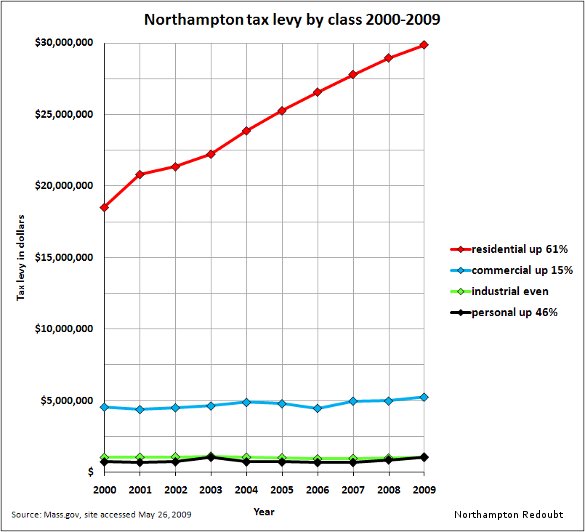 |
|
A few days ago I penned a blog on the tax levy increases for single family parcels in the city of Northampton. Upon further examination I found more information in plain view on the state's website regarding all of the classes of property in the city, and their aggregate tax levies. The findings are that Northampton's residential property taxpayers collectively have realized average annual tax increases of about 6.1% per year for the past ten years using 2000 as the base. I believe this is as a result of the addition of about 170 new residential units and increased property assessments. Commercial property taxpayers have seen annual increases of about 1.5% a year during that time period and industrial property taxpayers have actually seen a very slight decline of about .0035% annually. The payers of personal property taxes, which are basically taxes on business equipment, have seen annual increases of about 4.6%, but since the base for that sector is relatively low, this has almost been inconsequential when juxtaposed with residential property taxpayers. In response to my earlier post Downey Meyer left comments related to the inflation rate, stating essentially that due to the rate of inflation the increases to single family parcels is not as significant as it appears. If however, one applies that logic to the other classes of property one would find that commercial and industrial property owners have actually realized a reduced tax burden because of the inflation rate. Perhaps this reduced tax burden played into the creation of the controversial Business Improvement District. Clearly some business owners feel that they have the funds to pay more for services. These statistics present the beginning of an argument that would support a split tax rate between residential property owners and commercial/industrial property owners that would more equitably distribute the tax burden. Resident Leslie Fraidstern has brought this issue up before the council repeatedly. Considering many local businesses opted into the newly created Business Improvement District, perhaps the time has come for Mayor Higgins and the city council to consider deliberating more seriously such a policy. Considering the increases in the residential sector, in my view the taxes paid by commercial/industrial property owners should be connected somewhat to the rate of inflation. |


